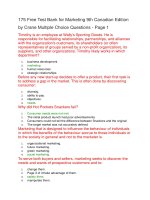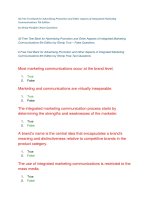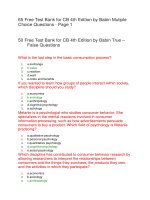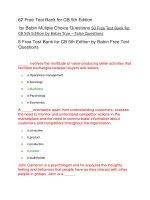101 free test bank for organizational behavior 9th
Bạn đang xem bản rút gọn của tài liệu. Xem và tải ngay bản đầy đủ của tài liệu tại đây (130.58 KB, 25 trang )
60 Free Test Bank for Organizational Behavior 9th
Edition by Kreitner True – False Questions
6 Free Test Bank for Organizational Behavior 9th
Edition by Kreitner Free Text Questions
41 Free Test Bank for Organizational Behavior 9th
Edition by Kreitner Multiple Choice Questions
Corporate officers in the United States are subject to high accountability
standards and harsh penalties under the ______ Act.
1.
A. Swart-Surber
2.
B. Hayes-Rachel
3.
C. Gambino
4.
D. Sarbabes-Oxley
5.
E. Brown
_____ represents the productive potential of an individual's knowledge
and actions.
1.
A. The Hawthorne legacy
2.
B. McGregor's Theory X
3.
C. Human capital
4.
D. E-business
5.
E. Social capital
Which of the following is not associated with higher profits and lower
turnover?
1.
A. Layoffs
2.
B. Careful hiring
3.
C. Generous pay
4.
D. A lack of emphasis on status
5.
E. Trust
A _____ probes individual or group processes in an organizational
setting.
1.
A. case study
2.
B. meta-analysis
3.
C. sample survey
4.
D. field study
5.
E. laboratory study
A _____ is a statistical pooling technique that allows behavioral scientists
to draw conclusions about certain variables from many different studies.
1.
A. case study
2.
B. meta-analysis
3.
C. sample survey
4.
D. field study
5.
E. laboratory study
_____ represents the productive potential resulting from strong
relationships, goodwill, trust, and cooperative effort.
1.
A. The Hawthorne legacy
2.
B. McGregor's Theory X
3.
C. Human capital
4.
D. E-business
5.
E. Social capital
Which of the following is a characteristic of a 21st century manager?
1.
A. Vertical communication patterns
2.
B. Compensation based on time and effort
3.
C. A competitive view of interpersonal relationships
4.
D. Resistance to change
5.
E. Sharing key information.
Clark Wilson's research outlined 11 skills exhibited by effective managers.
Which of the following is one of those managerial skills?
1.
A. Provides feedback on yearly intervals
2.
B. Makes unilateral decisions
3.
C. Provides intense pressure for goal accomplishment
4.
5.
D. Empowers and delegates duties to others while maintaining goal clarity and
commitment
E. Uses punishment and coercion to achieve performance.
As early as the 1920s, _____ advised managers to motivate job
performance instead of merely demanding it. In other words, (s)he
advocated a "pull" rather than a "push" strategy.
1.
A. Douglas McGregor
2.
B. Kristin McKay
3.
C. W. Edwards Deming
4.
D. Henry Mintzberg
5.
E. Mary Parker Follett.
In a ___, variables are manipulated and measured in controlled situations.
1.
A. case study
2.
B. meta-analysis
3.
C. sample survey
4.
D. field study
5.
E. laboratory study
Which of the following is the core profession that OB students typically
specialize in when they enter organizations?
1.
A. CEO
2.
B. COO
3.
C. CFO
4.
D. COB
5.
E. none of the above
According to W. Edwards Deming, _____ is required to uncover system
(e.g., machinery) failures.
1.
A. a fearful work environment
2.
B. new leadership
3.
C. an interview with the attending supervisor
4.
D. an interview with the employee responsible
5.
E. statistical analysis
In the 1933 classic, The Human Problems of an Industrial Civilization,
_____ advised managers to attend to employees' emotional needs.
1.
A. Douglas McGregor
2.
B. Elton Mayo
3.
C. W. Edwards Deming
4.
D. Henry Mintzberg
5.
E. Mary Parker Follett
According to the principles of total quality management (TQM),
improvement is _____ driven.
1.
A. stakeholder
2.
B. management
3.
C. leader
4.
D. employee
5.
E. industry
W. Edwards Deming had much to say about how employees should be
treated. Among other things, he called for ___.
1.
A. formal training in managerial techniques
2.
B. an emphasis on individual responsibility
3.
C. elimination of barriers to good workmanship
4.
D. emphasis on numerical quotas
5.
E. order giving and punishment.
According to a 2008 survey, students at religious schools, relative to
students at public schools, are significantly more likely to ___.
1.
A. follow ethical rules of conduct
2.
B. cheat
3.
C. attend college
4.
D. effectively preserve their ideals throughout their lives
5.
E. work in the non-profit sector
Of the following, which is a characteristic of a 21st-century manager?
1.
A. Compensation based on time, effort, and rank.
2.
B. Viewing people as a primary resource.
3.
C. A monocultural, monolingual orientation.
4.
D. Ethical considerations are made as an afterthought.
5.
E. Hoarding power and key information.
A common principle underlying various total quality management (TQM)
programs is that one should ___.
1.
A. trace defective items back to the individual responsible
2.
B. maintain a strong distinction between labor and management
3.
C. listen and learn from competitors
4.
D. maintain a strong Quality Inspection department
5.
E. do it right the first time to eliminate costly rework
(_____ calls for using management techniques in a situationally
appropriate manner instead of relying on ‘one best way.'
1.
A. Human resource development
2.
B. Organizational behavior
3.
C. The human relations movement
4.
D. The contingency approach
5.
E. Total quality management
According to W. Edwards Deming, when things go wrong, there is roughly
a(n) ______ percent chance the system (e.g., management, machinery, or
rules) is at fault and about a _____ percent chance the individual
employee is at fault.
1.
A. 55; 45
2.
B. 65; 35
3.
C. 75; 25
4.
D. 85; 15
5.
E. 95; 05
"Continuous, customer-centered, employee-driven improvement" defines
___.
1.
A. total quality management
2.
B. the contingency approach
3.
C. the human relations movement
4.
D. organizational behavior
5.
E. the Hawthorne legacy
_____ is the process of working with and through others to achieve
organizational objectives in an efficient and ethical manner.
1.
A. Total quality management
2.
B. Management
3.
C. The human relation movement
4.
D. Organizational behavior
5.
E. The contingency approach
A _____ is an in-depth analysis of a single individual, group, or
organization.
1.
A. Case study
2.
B. Meta-analysis
3.
C. Sample survey
4.
D. Field study
5.
E. Laboratory study
Why should one spend one's time learning about organizational
behavior?
1.
A. To learn how to interact with others more effectively
2.
B. To increase the chances of becoming a successful manager
3.
C. To better understand human behavior
4.
D. To increase self-management skills
5.
E. All options are correct
A recent review of 30 years of business literature led to the conclusion
that good management requires ___.
1.
A. a clear purpose and a bias toward action
2.
B. a willingness to put oneself before the organization
3.
C. the occasional "bending of the rules"
4.
D. an IQ of at least 130
5.
E. extensive Six Sigma training
Based on later interviews and re-analysis of the original data, which of the
following was likely not responsible for the high production output at
Western Electric's Hawthorne plant?
1.
A. Fear of unemployment during the Great Depression
2.
B. Supportive supervision
3.
C. High-quality raw materials
4.
D. Money
5.
E. Managerial discipline
The objective of organizational behavior is to develop a better ___.
1.
A. understanding of competitors
2.
B. understanding of people at work
3.
C. collective processes
4.
D. indoctrination system for employees
5.
E. fit with the external environment
_____ refers to buying and selling goods and services over the Internet
whereas _____ refers to using the Internet to facilitate every aspect of
running a business.
1.
A. Virtual organization; virtual team
2.
B. E-business; E-mail
3.
C. E-mail; E-commerce
4.
D. Virtual team; virtual organization
5.
E. E-commerce; E-business
Which of the following is an assumption of McGregor's Theory X? The
typical person ___.
1.
A. dislikes work and will avoid it if possible
2.
B. views work as a natural activity, like play or rest
3.
C. can learn to accept and seek responsibility
4.
D. is capable of self-direction and self-control
5.
E. has imagination, ingenuity, and creativity
_____ is based on a positive set of assumptions about human nature.
1.
A. Theory Q
2.
B. Theory W
3.
C. Theory X
4.
D. Theory Y
5.
E. Theory Z
In Hodgson's seven moral principles, the notion of the sanctity of human
life is captured by ___.
1.
A. dignity of human life
2.
B. autonomy
3.
C. honesty
4.
D. loyalty
5.
E. humaneness
The base of Carroll's Global Corporate Social Responsibility Pyramid is
_____ responsibility.
1.
A. economic
2.
B. legal
3.
C. ethical
4.
D. philanthropic
5.
E. egoistic
_____ is based on pessimistic and negative assumptions about human
nature.
1.
A. Theory Q
2.
B. Theory W
3.
C. Theory X
4.
D. Theory Y
5.
E. Theory Z
Those born into the so called "net generation" place a premium on ___.
1.
A. isolation
2.
B. trust
3.
C. tradition
4.
D. structure
5.
E. freedom
Evidence suggests that people-centered management practices are
associated with ___.
1.
A. higher profits
2.
B. higher turnover
3.
C. more centralized decision making
4.
D. increased layoffs
5.
E. Increased emphasis on hierarchical status
Intel spends millions of dollars each year to encourage education in math
and science. This policy ___.
1.
A. builds human capital
2.
B. wastes organizational resources
3.
C. increases employee turnover
4.
D. reflects a Theory X view of human nature
5.
E. contradicts the teachings of Mary Parker Follett
_____ are characterized by high research precision.
1.
A. Field studies
2.
B. Sample surveys
3.
C. Laboratory studies
4.
D. Case studies
5.
E. Meta-analyses
In Hodgson's seven moral principles, the notion of self determination is
captured by ___.
1.
A. dignity of human life
2.
B. autonomy
3.
C. honesty
4.
D. loyalty
5.
E. humaneness
The three basic levels of analysis in organizational behavior are ___.
1.
A. psychological, sociological, and statistical
2.
B. emotional, physical, and cognitive
3.
C. Functional, business, and strategic
4.
D. Individual, group, and organizational
5.
E. group, individual, and environmental
Which of the following is an assumption of McGregor's Theory Y? The
typical person ___.
1.
A. has imagination and creativity
2.
B. cares only about security
3.
C. prefers to be directed
4.
D. avoids work if possible
5.
E. requires close supervision
Research by Henry Mintzberg and others has found that a typical
manager's day ___.
1.
A. is a fragmented collection of brief episodes
2.
B. has few interruptions
3.
C. has large blocks of time for planning
4.
D. is conducive to reflective thinking
5.
E. is mainly spent planning and allocating resources
60 Free Test Bank for Organizational Behavior 9th
Edition by Kreitner True - False Questions - Page 1
Organizational behavior is a specific job category in most organizations
(e.g., the "COBO" or the Chief Organizational Behavior Officer).
1.
True
2.
False
According to Jeffrey Pfeffer nearly 90% of today's organizations are truly
"people centered."
1.
True
2.
False
Research evidence suggests that increasing job security is associated
with higher profits and lower employee turnover.
1.
True
2.
False
The World Health Organization, General Motors, and Al Qaeda are all
examples of formally defined organizations.
1.
True
2.
False
Total quality management is established today thanks in large part to the
pioneering work of Douglas S. Surber.
1.
True
2.
False
According to the text, there are three levels of OB analysis: individuals,
groups, and organizational.
1.
True
2.
False
The ultimate goal of Six Sigma is to come within six standard deviations
of perfection.
1.
True
2.
False
Travelocity is a company that believes in the ethical treatment and
development of employees.
1.
True
2.
False
Practical experience and research both tell us that layoffs should increase
the motivation of remaining employees.
1.
True
2.
False
Michelle Peluso, CEO of Travelocity, subscribes to McGregor's Theory X
views concerning employees.
1.
True
2.
False
McGregor's Theory X asserts that employees must be coerced and
threatened with punishment before they will work.
1.
True
2.
False
Providing training for employees leads to lower employee turnover.
1.
True
2.
False
Reanalysis of the original Hawthorne data strongly supports initial
conclusions about the positive effect of supportive supervision.
1.
True
2.
False
From a philosophical perspective, McGregor's Theory X places a greater
emphasis on human potential than does his Theory Y.
1.
True
2.
False
Six Sigma promotes intense scrutiny of how a process is defined,
measured, analyzed, improved, and marketed.
1.
True
2.
False
Legalization of union-management collective bargaining helped foster the
human relations movement.
1.
True
2.
False
Confidence, hope, optimism, subjective well-being, and emotional
intelligence are the five key dimensions of McGregor's Theory X.
1.
True
2.
False
Organizational behavior is a vertical discipline functioning in the human
resource realm.
1.
True
2.
False
Writer Elton Mayo advised managers to attend to employees' emotional
needs.
1.
True
2.
False
According to Jeffrey Pfeffer, companies must choose between stressing
continuous improvement and making employees feel comfortable.
1.
True
2.
False
In successful improvement programs, Total quality management
principles are embedded in the organization's culture.
1.
True
2.
False
Douglas McGregor believed managers could accomplish more by first
admitting that employees are intrinsically selfish and lazy and then
working to remedy that fatal flaw.
1.
True
2.
False
According to McGregor's Theory Y, the typical employee can learn to
accept and seek responsibility.
1.
True
2.
False
An organization is a system of consciously coordinated activities of two
or more people.
1.
True
2.
False
Total quality management (TQM) is defined as continuous, customercentered, employee-driven improvement.
1.
True
2.
False
Mary Parker Follett urged managers to demand job performance instead
of merely attempting to elicit it from employees: a "push" rather than
"pull" strategy.
1.
True
2.
False
According to McGregor's Theory X, people tend to procrastinate and loaf
whenever they can.
1.
True
2.
False
OB is an interdisciplinary field dedicated to better understanding and
managing people solely in for profit business environments.
1.
True
2.
False
60 Free Test Bank for Organizational Behavior 9th
Edition by Kreitner True - False Questions - Page 2
A recent review of 30 years of business literature led to the conclusion
that good management requires a clear purpose and a bias toward action.
1.
True
2.
False
Intelligence, creativity, motivation and enthusiasm are dimensions of
social capital.
1.
True
2.
False
E-business involves using the Internet to buy and sell goods and services
whereas e-commerce involves using the Internet to facilitate every aspect
of running a business.
1.
True
2.
False
Henry Mintzberg discovered that managers typically devote large blocks
of time to planning.
1.
True
2.
False
At its core, management is about dealing effectively with people.
1.
True
2.
False
W. Edwards Deming believed that formal training in statistical process
control is unnecessary (and even counterproductive) in modern
organizations.
1.
True
2.
False
The successful 21st century manager shares access to power and key
information.
1.
True
2.
False
An organization's ethical climate can be improved by developing a
meaningful code of ethics.
1.
True
2.
False
According to a 2008 survey, students at religious schools are significantly
less likely to cheat than students at non-religious schools.
1.
True
2.
False
Members of the "Net Generation" are generally unskilled at collaboration
due to their painfully awkward social skills and questionable hygiene.
1.
True
2.
False
Human capital is the productive potential of an individual's knowledge and
actions.
1.
True
2.
False
The primary role of a 21st century manager is to give orders and control
action.
1.
True
2.
False
A successful 21st century manager views people as a potential problem.
1.
True
2.
False
Trust, mutual respect, teamwork, and camaraderie are dimensions of
social capital.
1.
True
2.
False
"Kindness to the helpless" is the most basic and essential of Kent
Hodgison's seven moral principles.
1.
True
2.
False
In the early 1990s, even when Internet applications were undergoing a
growth spurt, advocates said it would amount to nothing in the end.
1.
True
2.
False
Studies in the United States and the United Kingdom demonstrate that
corporate commitment to ethics typically comes at a large bottom line
cost to the organization.
1.
True
2.
False
Because of the highly controlled nature of laboratory studies, generalizing
the results to organizational management requires caution.
1.
True
2.
False
Those born into the so-called "Net Generation" place a high value on
freedom.
1.
True
2.
False
Deming would likely endorse a business model wherein organizational
improvement is addressed, in a meaningful and intense way, once a year
at an annual meeting.
1.
True
2.
False
A field study is a statistical pooling technique allowing behavioral
scientists to draw general conclusions about certain variables from many
different studies.
1.
True
2.
False
Social capital is productive potential resulting from strong relationships,
goodwill, trust, and cooperative effort.
1.
True
2.
False
The highest level of Carroll's Global Social Responsibility Pyramid is
occupied by ethical responsibility.
1.
True
2.
False
Corporate officers in the U.S. are largely protected from harsh criminal
penalties by the Sarbanes-Oxley Act of 2002.
1.
True
2.
False
According to W. Edwards Deming, when things go wrong, there is roughly
a 60% chance that the system (e.g., management, machinery, or rules) is
at fault and about a 40% chance that the individual employee is at fault.
1.
True
2.
False
After a review of 30 years of business literature, it was concluded that to
be an effective manager one must be very sensitive both to past
experience and to the mass of new information available through digital
sources.
1.
True
2.
False
A successful 21st century manager seeks to facilitate change.
1.
True
2.
False
Managers of the future will be compensated based on time, effort, and
rank.
1.
True
2.
False
Managers with high levels of skill mastery tend to have better subunit
performance and employee morale than managers with lower levels of
skill mastery.
1.
True
2.
False
According to Henry Mintzberg, the most vital job in our society is that of
the manager.
1.
True
2.
False
According to recent research, effective female and male managers have
significantly different skill profiles.
1.
True
2.
False
A nationwide survey of human resource professionals revealed that only
11% occasionally observed unethical behavior at their organizations.
1.
True
2.
False
6 Free Test Bank for Organizational Behavior 9th
Edition by Kreitner Free Text Questions
Organizational behavior is a science built on the foundation of a number
of older academic and applied fields. What are some of these fields and
what are their unique contributions to organizational behavior? Be
complete in your response and include, at a minimum, five contributing
fields.
Answer Given
[The book lists 17 disciplines and there are actually many more. This example
answer concentrates on a sample of 5 disciplines. Answers may range broadly as
this question calls for a synthesis of what students know about other fields in
conjunction with what they're learning about OB.] Organizational behavior has
been built upon the contributions of psychology, sociology, social psychology,
anthropology, and political science. Psychology has contributed to learning,
perception, personality, emotions, training, leadership effectiveness, needs and
motivational forces, job satisfaction, decision-making processes, performance
appraisals, attitude measurement, employee selection techniques, work design,
and job stress. Sociology has contributed through the study of formal and complex
organizations - including group dynamics, design of work teams, organizational
culture, formal organization theory and structure, organizational technology,
communications, power, and conflict. Social psychology has contributed in the
areas of measuring, understanding, and changing attitudes; communication
patterns; building trust; the ways in which group activities can satisfy needs; and
group decision-making processes. Anthropology has contributed to an
understanding of organizational culture, organizational environments, and
differences between national cultures. Political science has contributed to an
understanding of structuring of conflict, allocation of power, and how people
manipulate power for individual self-interest. One strength of organizational
behavior is its ability to help us understand complex subjects by combining the
perspectives offered from such diverse disciplines.
What is the difference between e-commerce and e-business? Describe the
E-business implications for organizational behavior.
Answer Given
E-commerce refers to the buying and selling of goods and services over the
Internet. E-business is much broader in scope and refers to the use of the Internet
to facilitate every aspect of running a business. E-business can radically alter any
activity that depends significantly on the flow of information. This might include
everything from customer needs and product design to prices, schedules,
finances, employee performance data, and corporate strategy. Managers and
employees have access to greater quantities of information because
communication crosses traditional organizational boundaries.
Describe the assumptions behind McGregor's Theory X and Theory Y.
How can McGregor's Theory Y assumptions be applied to the problems of
managing in a modern working environment?
Answer Given
Theory X assumptions are pessimistic and negative in nature. It is assumed that
people dislike work and will avoid it when possible, that they must be coerced and
threatened and that they prefer to be directed. Theory Y assumptions are positive
in nature. In this case, it is assumed that people are capable of self-direction, they
will be committed to organizational objectives if they are rewarded for doing so,
and the typical employee will seek responsibility and has imagination, ingenuity
and creativity. Surveys suggest that most employees would prefer to become an
integral part of the organization, but they feel a lack of connection with their
supervisor or with the organization. Theory Y assumptions expressed by
managers would help heal this disconnect between employees and organizations.
Identify the seven general ethical principles and briefly describe each.
Answer Given
The seven general ethical principles include dignity of human life, autonomy,
honesty, loyalty, fairness, humaneness, and the common good. Dignity of human
life means that humans have a right to live and to be treated with respect.
Autonomy means that all persons are intrinsically valuable and thus have rights to
self-determination and equal human liberty. Honesty means that the reality of the
situation should be told to those who have a right to know it. Loyalty means that
promises, contracts, and commitments should be honored. Fairness means that
one has a right to be treated fairly, impartially, and equitably, and has the
obligation to treat others fairly and justly. Humaneness means that our actions
ought to do good to ourselves and others and we should avoid doing evil. The
common good means that actions should benefit the welfare of the largest number
of people while trying to protect the rights of individuals.
Compare and contrast the characteristics of past managers and 21st
century managers.
Answer Given
Past managers saw themselves as order-givers who relied on formal authority as
a source of influence. Communication patterns were typically vertical in nature and
information was restricted. Employees were often viewed as a source of problems
and competitive interpersonal relationships. 21st century managers see
themselves as facilitators and coaches. They rely on technical and interpersonal
knowledge as a power base. Communication flows in multiple directions and
information is shared. Employees are viewed as a valued resource and partners in
cooperative interpersonal relationships.
Define human capital. Describe the qualities and characteristics of
individual human capital. Which of these characteristics do you see in
yourself?
Answer Given
Human capital is the productive potential of an individual's knowledge and actions.
Characteristics of human capital include individual intelligence, aspirations,
technical and social skills, self-esteem, initiative, adaptability, readiness to learn,
creativity, enthusiasm, motivation and commitment, persistence, ethical standards,
honesty and emotional maturity. How students relate these constructs to their own
experience will vary broadly.









